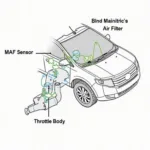How to read codes without OBD2 on a Dodge? It’s a common question for owners of older models or those facing a sudden malfunction. While an OBD2 scanner is the preferred method for retrieving diagnostic trouble codes (DTCs), there are alternative ways to access this crucial information, especially on pre-OBD2 Dodges. This guide will walk you through those methods, helping you understand what your Dodge is trying to tell you.
Deciphering Dodge Trouble Codes Without a Scanner
Before OBD2 became standard in 1996, Dodge vehicles relied on various systems for communicating diagnostic information. These methods often involved retrieving codes through blinking lights, listening for specific tones, or using jumper wires. Understanding these older systems can be invaluable when dealing with a pre-OBD2 Dodge. This can save you time and money, allowing you to pinpoint potential issues before heading to a mechanic.
Using the Key Trick Method on Certain Dodge Models
Some Dodge models allow you to retrieve codes by turning the ignition key on and off in a specific sequence. This “key trick” method usually involves turning the key from the “off” position to the “on” position (without starting the engine) three times in rapid succession, ending in the “on” position. If successful, the check engine light or another indicator will begin to flash, displaying a series of codes. These codes correspond to specific issues within the vehicle’s systems.
However, this method isn’t universal and varies between Dodge models and years. Consulting your vehicle’s service manual is crucial to determine the correct procedure for your specific Dodge. Using the wrong sequence could yield no results or even trigger unintended consequences.
Reading Flash Codes on Older Dodge Vehicles
Older Dodge models often communicate trouble codes through flashing lights, commonly the check engine light. Counting the flashes and pauses reveals the code. For example, two flashes followed by a pause, then three flashes, would indicate a code 23. foxwell obd2 scanner nt624 can make this process much easier.
Interpreting these codes requires a reference guide or service manual specific to your vehicle’s year and model. These manuals provide detailed descriptions of each code and its corresponding fault. Remember, while this method can be effective, it might not be as comprehensive as using an OBD2 scanner, especially for complex issues.
Understanding Dodge Diagnostic Connectors
Before OBD2 standardization, Dodge employed various diagnostic connectors. Identifying the correct connector for your specific model is essential for accessing diagnostic information. These connectors often differ in shape, size, and pin configuration.
Locating the Diagnostic Connector on Your Dodge
The diagnostic connector is usually located under the dashboard, near the steering column, or in the engine compartment. Consulting your vehicle’s service manual is the best way to pinpoint its exact location. diesel obd2 scanner cummins can be used on some diesel models.
“Knowing the specific location of the diagnostic connector on your Dodge model is crucial for effective troubleshooting,” says John Miller, a seasoned automotive technician with over 20 years of experience. “This allows you to quickly access the vital diagnostic information your vehicle is communicating.”
Jumper Wire Method for Retrieving Codes
On certain pre-OBD2 Dodges, you can use a jumper wire to retrieve codes. This involves connecting specific pins on the diagnostic connector, often labeled “A” and “B”, and observing the flashing check engine light or listening for specific tones.
“While the jumper wire method might seem a bit archaic compared to modern OBD2 scanners, it can be surprisingly effective in retrieving diagnostic codes on older Dodge models,” explains Sarah Johnson, an automotive electronics expert. “It’s a simple yet powerful technique that can save you a trip to the mechanic.” obd2 drive cycle dodge grand caravan may also be helpful.
Conclusion: How to Effectively Read Dodge Codes Without OBD2
Reading codes without an OBD2 scanner on a Dodge requires understanding your vehicle’s specific system. Whether using the key trick, reading flash codes, or employing the jumper wire method, consulting your service manual is crucial. While these methods can be effective for older models, an mazda obd2 code reader is the most efficient way to diagnose issues on OBD2-equipped Dodges. does the 2017 dodge ram have obd2 port – the answer is yes! Understanding how to retrieve these codes is essential for maintaining your Dodge and addressing potential issues promptly.
FAQ
- What if my Dodge doesn’t have an OBD2 port?
- Where can I find the service manual for my Dodge?
- Are there any risks associated with using the jumper wire method?
- What do the different flash codes mean on my Dodge?
- Can I clear the codes after reading them without an OBD2 scanner?
- Is the key trick method reliable?
- What should I do if I can’t retrieve any codes using these methods?
For assistance, contact us via WhatsApp: +1(641)206-8880, Email: [email protected], or visit us at 789 Elm Street, San Francisco, CA 94102, USA. We offer 24/7 customer support.
